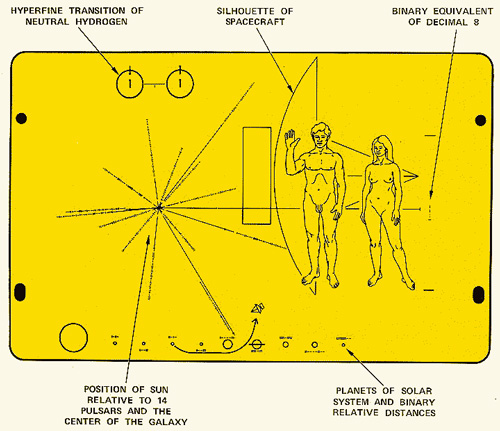LAWS OF THE UNIVERSE (1)
By:
August 18, 2017
One in a series of ten posts reprinting installments of HILOBROW friend Chris Spurgeon’s LAWS OF THE UNIVERSE, a newsletter celebrating the rules, constants, principles, theorems, effects “shining a tiny bit of light onto one tiny bit of how the universe operates.”
Mathematical estimation of the number of extraterrestrial civilizations in the Milky Way galaxy.
Enrico Fermi was one of the greatest physicists of the 20th century. He created the first nuclear reactor, helped design the atomic bomb, was the first person to create a man-made element, and won a Nobel Prize.

Fermi was the rare physicist who was both a brilliant theoretician and a highly skilled experimenter.(*) He was renowned for making accurate predictions of the results of experiments with only the scantest amount of actual data. For example, when the first atomic bomb was detonated in the New Mexico desert, Fermi witnessed the event. When the blast wave reached his position he dropped a piece of paper and observed how far it flew. Based on that, he made a surprisingly accurate estimation of the explosive force of the detonation.
These days, the term Fermi problem is used to describe any question that seems at first glance to be impossible to answer without additional information, but can be at least approximately solved through rough estimation. Here’s a typical Fermi problem…
If all of the hot dogs Americans eat in a year were laid end to end, would they reach the moon?
You could probably just Google the answer, but let’s see if we can reason it out. Here’s a typical way you could solve it:
- Without looking it up, I believe there’s something like 300 million people in America.
- I have no idea how many hot dogs the average American eats every year. Some people never eat a hot dog, while I bet there are some people out there who eat hot dogs every single day of their lives…
- OK, that’s 300 million people times 2.5 hot dogs each, for a total of 750 million hot dogs per year.
- How long is a hot dog? Well, from the times I’ve bought hot dogs I know that a “foot-long” hot dog is bigger than your average dog. So a regular dog is a bit shorter than that. Let’s guesstimate that the average hot dog is 9 inches (or .75 feet long).
- That means the total length of all of the hot dogs would be 750 million times .75 feet, or 562.5 million feet.
- I remember from elementary school that there are 5,280 feet in a mile. So dividing that length by 5,280 gives a hot dog length of about 106,500 miles.
- I remember from college that the moon is about 240,000 miles away, so I’m gonna say that, nope, all of the hot dogs eaten by Americans in a year wouldn’t reach to the moon. It looks like they’d only make it a bit less than halfway.(**)

Let’s say over the course of a year the average American eats 2 or 3 hotdogs. I’ll split the difference and call it 2.5.
Now, this answer is almost certainly wrong. But it’s probably not THAT wrong. Maybe the average American eats five hot dogs a year, or 10, or just one. So my answer may be off by a a factor or two or ten, but I bet it’s not off by a factor of 100 or 1,000.
Physicists, who deal with an extraordinary range of phenomena, from the weakest and smallest sub-atomic particles to the size and mass of the total universe, often make use of Fermi problems to get a first approximation of an answer to seemingly unanswerable questions.
In 1961, astronomer Frank Drake used Fermi’s technique to try to answer one of the biggest, most important questions ever posed by mankind: are we alone in the universe?
No serious astrobiologist believes that intelligent beings from another planet have ever made it to earth, or ever will. The interstellar distances are just too vast. Our only hope of discovering life beyond our solar system is if an alien civilization transmitted some sort of communication, and we received it.
We humans have been able to send signals (first telegraph, then later radio, television, microwave, data, you name it) out into space for a bit more than a century. Drake decided to see if he could work out the likelihood of any other life forms in our galaxy being able to do that too. Here’s the equation he came up with…

Let’s break the equation down. N stands for the number of civilizations in the Milky Way galaxy with detectable electromagnetic transmissions.
R* is a measure of how often stars form that could eventually host a planet that includes intelligent communicating life.
The four parts of the equation with the letter “f” are all fractions. In order, they stand for:
- The percentage of stars that have planets orbiting them.
- The percentage of those planets that develop life.
- The percentage of those life bearing planets that develop intelligent life.
- The percentage of intelligent civilizations that develop a technology that can transmit an interstellar signal.
To finish off the equation, ne stands for how many planets a typical star possesses, and L is how long a given civilization transmits signals into space.
From the beginning, Drake readily admitted that the equation which now bears his name is filled with variables that are (at least currently) virtually impossible to estimate. He thought the real value of the equation was as a leaping off point for more general discussions about the possibility of life elsewhere.
Nevertheless, in 1961 Drake and his colleagues did go ahead and plug some best guess numbers into the equation. Here’s what they came up with…
R* = 1 new star formed per year.
fp = 0.2 to 0.5 (between 20% and 50% of all stars form planets).
ne = 1 to 5 (stars with planets have between 1 and 5 planets that could possibly support life)
fl = 1 (all of those planets will develop life)
fi = 1 (all of the planets that develop life will develop intelligent life)
fc = 0.1 to 0.2 (10% to 20% will develop suitable communication technology)
L = 1,000 to 100,000,000 (how many years a civilization will survive)
Using the worst case values for all of those numbers, the Drake equation says that right now in the Milky Way there are 20 alien worlds trying to communicate to us. Plug in the most optimistic values and that number explodes all the way up to 100,000,000. Quite a range.

As you might expect, there have been all sorts of critiques of the Drake equation, and suggestions for ways to modify it. Some scientists speculate that typical civilizations will end up colonizing other planets in their solar system, increasing the potential sources for extraterrestrial signals. Others say that many alien planets are bombarded by radiation from their sun, making the evolution of intelligent life much less probable. It’s all so extraordinarily speculative that it’s almost certain we’ll never know if anyone else is out there.
But that doesn’t mean we shouldn’t keep listening.

Frank Drake (born 1930) grew up in Chicago and attended Cornell and Harvard Universities, where he studied radio astronomy. He later studied Jupiter’s atmosphere, worked on pulsar research, and ran the giant Arecibo radio telescope in Puerto Rico.
In 1960 Drake was the first earthling to make a serious attempt to search for extraterrestrial life. He pointed the giant radio telescope in Green Bank, West Virginia, at two nearby stars similar to our sun. After several months of listening he reported no sign of alien signals. Drake is also co-creator of the most distant artwork ever made by humans.(****)

Along with astronomer Carl Sagan, Drake designed the plaque affixed to the Pioneer spacecraft. On the ridiculously tiny chance that an alien life form ever sees this object, it will hopefully convey some information about the strange creatures who created it and launched it toward the stars.
(*) On the other hand, Einstein may have been a theorist nonpareil, but I wouldn’t have trusted the guy to change a light bulb.
(**) BTW, according to the Huffington Post, the best hot dog in the world isn’t made in America; it’s made in Reykjavik, Iceland. I’m had ’em, they’re absolutely right. The best hotdogs in major league baseball are at Miller Park, home of the Milwaukee Brewers. Absolutely the worst, most gag-inducing hot dog anywhere in baseball are the ones sold by the Los Angeles Dodgers at Dodger Stadium.
(***) The earth’s magnetic field and atmosphere shield us from many of the worst effects of solar radiation.
(****) Yes, I know that the Voyager spacecraft are now further out from the Earth than the Pioneers, and that they each carry a golden record that contains images of earth, as well as audio recordings. And I know that those recordings include Chuck Berry doing Johnny B. Goode, and that there has been no greater work of art created in the history of human civilization than that. But I’m talking about art that you can immediately see with the naked eye. Or eye stalks. Or phosphor covered electro-biological capture devices. Or whatever the hell it is that those aliens are using for eyes these days.
CURATED SERIES at HILOBROW: UNBORED CANON by Josh Glenn | CARPE PHALLUM by Patrick Cates | MS. K by Heather Kasunick | HERE BE MONSTERS by Mister Reusch | DOWNTOWNE by Bradley Peterson | #FX by Michael Lewy | PINNED PANELS by Zack Smith | TANK UP by Tony Leone | OUTBOUND TO MONTEVIDEO by Mimi Lipson | TAKING LIBERTIES by Douglas Wolk | STERANKOISMS by Douglas Wolk | MARVEL vs. MUSEUM by Douglas Wolk | NEVER BEGIN TO SING by Damon Krukowski | WTC WTF by Douglas Wolk | COOLING OFF THE COMMOTION by Chenjerai Kumanyika | THAT’S GREAT MARVEL by Douglas Wolk | LAWS OF THE UNIVERSE by Chris Spurgeon | IMAGINARY FRIENDS by Alexandra Molotkow | UNFLOWN by Jacob Covey | ADEQUATED by Franklin Bruno | QUALITY JOE by Joe Alterio | CHICKEN LIT by Lisa Jane Persky | PINAKOTHEK by Luc Sante | ALL MY STARS by Joanne McNeil | BIGFOOT ISLAND by Michael Lewy | NOT OF THIS EARTH by Michael Lewy | ANIMAL MAGNETISM by Colin Dickey | KEEPERS by Steph Burt | AMERICA OBSCURA by Andrew Hultkrans | HEATHCLIFF, FOR WHY? by Brandi Brown | DAILY DRUMPF by Rick Pinchera | BEDROOM AIRPORT by “Parson Edwards” | INTO THE VOID by Charlie Jane Anders | WE REABSORB & ENLIVEN by Matthew Battles | BRAINIAC by Joshua Glenn | COMICALLY VINTAGE by Comically Vintage | BLDGBLOG by Geoff Manaugh | WINDS OF MAGIC by James Parker | MUSEUM OF FEMORIBILIA by Lynn Peril | ROBOTS + MONSTERS by Joe Alterio | MONSTOBER by Rick Pinchera | POP WITH A SHOTGUN by Devin McKinney | FEEDBACK by Joshua Glenn | 4CP FTW by John Hilgart | ANNOTATED GIF by Kerry Callen | FANCHILD by Adam McGovern | BOOKFUTURISM by James Bridle | NOMADBROW by Erik Davis | SCREEN TIME by Jacob Mikanowski | FALSE MACHINE by Patrick Stuart | 12 DAYS OF SIGNIFICANCE | 12 MORE DAYS OF SIGNIFICANCE | 12 DAYS OF SIGNIFICANCE (AGAIN) | ANOTHER 12 DAYS OF SIGNIFICANCE | UNBORED MANIFESTO by Joshua Glenn and Elizabeth Foy Larsen | H IS FOR HOBO by Joshua Glenn | 4CP FRIDAY by guest curators
